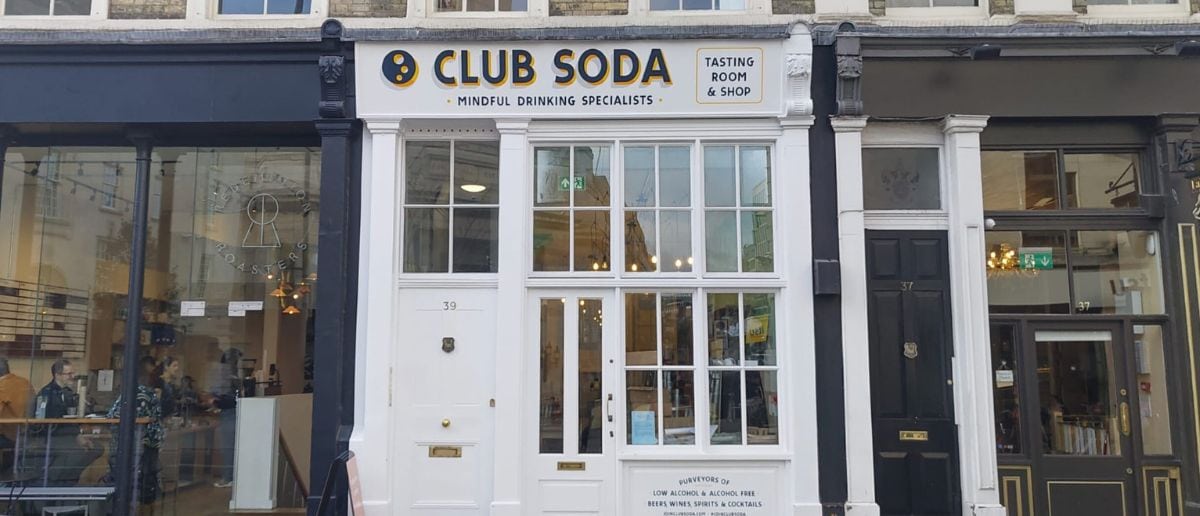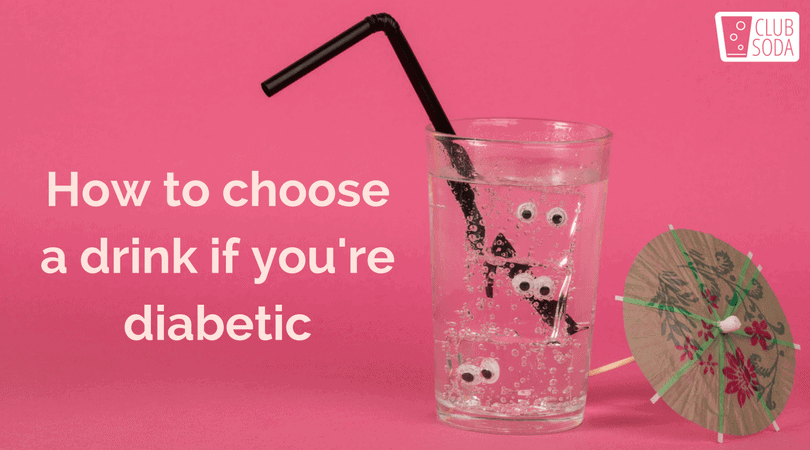
This website uses cookies to improve your experience. We'll assume you're ok with this, but you can opt-out if you wish. Read More
The Next Round: What happens after you change your drinking?

We talk a lot about alcohol and your health at Club Soda, and diabetes is one of the conditions that can make it more difficult to choose what to drink.
Over 300 million people in the world have Type 2 diabetes, making it a common condition. Regardless of your health, we believe in mindful drinking: thinking about what’s good for you physically and mentally. Whether you are diabetic, on a carb-controlled diet, or just trying to cut down on sugar or alcohol, scientists agree that switching to healthier drinks can save hundreds of calories and a lot of carbohydrates. So with that in mind, here are some things to know before you sip.
Please note that Club Soda is not a substitute for medical advice and should not be taken as such: we are not qualified to give it. Do always talk to your doctor if you have any health concerns, about your alcohol use, diabetes, or anything else.
While Type 1 diabetes is mostly diagnosed in childhood and requires insulin injections, Type 2 diabetes can often signal high blood pressure and is controlled without medication. With both types, the main issue to think about is: how sharply will what I drink impact on my blood sugar levels?
When you have diabetes, the most important thing is making sure what you drink is contributing to a balanced diet and lifestyle. So, the overall aim is to avoid a spike in blood sugar that is caused by drinks with a high sugar or carb content – and that includes alcoholic drinks.
For Type 1 diabetes, your insulin dose has been balanced against the amount of carbohydrates you usually consume. Having a healthy diet is always recommended, but if you drastically change it, make sure you consult your doctor first.
Carbs are important. They are broken down into sugars in our body, forming one of our most essential sources of energy. However, for diabetics, they are another way that sugar in drinks can be disguised and needs to be regulated.
The lowest carb drink you can have is obviously water, which contains zero calories and zero carbs. On the other end of the spectrum, the average glass of full fat coke contains 27g carbohydrates, all of which turns into sugar. Beer is also high in carbs, sometimes even being called “liquid bread”! Below, we’ve listed some interesting drinks in between that will help you stay healthy, yet score a 10/10 for sippable value on a night out with your mates.
| Drink | Carbs per 250ml serving (g) |
| Double Dutch Tonic – we think their cranberry tonic is delicious over ice with a squeeze of lime |
9.8g |
| Fresh mint, fresh lime and soda (or infuse with fruit of your choice) |
0g |
| Big Drop Brewing Co.’s Pale Ale – this deliciously dry-hopped ale is low carb for a beer |
8.5g |
| Virgin Mary – pimp your tomato juice by adding a dash of Worcester Sauce and splashing in some tabasco |
6.5g |
| FitBeer – a delicious, full-bodied beer that is also vegan, naturally isotonic and contains heaps of Folic acid. At only 66 calories a bottle, it is all about maximum pleasure and minimum guilt. | 10.18g |
If in doubt, make your own. Here are some recipes for delicious and flavourful low-carb drinks, including fruity iced teas, smoothies and a zingy green tea lemonade.
To avoid spikes in blood sugar, it helps to avoid drinks with a high sugar content. The main culprits are the ones which pubs love to serve on tap; coke, lemonade and Fanta can contain a whopping 7 teaspoons of sugar per serving. Surprisingly, fruit juices are little better, with most orange juices containing just over 5 teaspoons.
However, research into low sugar alternatives often shows that there is no straightforward compromise. Sure, diet drinks don’t contain any sugar, but the sweeteners they do contain are bad for the gut which can increase insulin resistance. And some of the natural sugars in fruit juice are actually good for you.
It’s important to remember that everyone’s blood sugar response to drinks is unique and individual. With that in mind, here are a range of drinks that are lower in sugar yet still interesting and flavourful.
| Drink | Sugar per 250ml serving (g) |
| Seedlip – an alcohol-free spirit that is free from sugar, sweeteners and calories. Add a couple of drops of Bitter Union’s aromatic bitters for notes of sour cherry and clove. |
50ml Seedlip + 200ml Low Calorie Tonic = 0g |
| Cold Brew Tea – make your own by infusing a tea bag in cold water for 4-8 hours. Our favourites are lemon and ginger, as well as jasmine tea. Add a dash of Holy Lama’s Spice Drops for an extra punch of flavour. |
0g |
| Elderbrook Cordials – these cordials use coconut nectar so they are sweet yet low in natural sugar. Pimp your water/fizzy water with something fruity and delicious |
1g |
| Cranberry, soda water and fresh lime – juice is sugary, but if you top it up with something else, you can create a healthier drink and still enjoy your favourite tipple. |
100ml juice + 150ml soda water = 3.9g |
| St. Peter’s Without – this full-bodied, alcohol-free craft beer has a distinctive malt flavour, a delicate bitterness, and next to no sugar. |
3g |
| Craft sodas such as Gusto Organic, Soda Folk and Square Root |
A third less sugar than their supermarket equivalents |
It can be complicated working all this out just from the back of a bottle, especially if key numbers are missing.
The recommended daily sugar intake for men is 36g, while for women it is 22g. Have these figures at the back of your mind when judging what you’re drinking.

Here is a standard nutrition label for an orange juice. Note that the label provides the nutritional value for 1 cup of juice (250g = 250ml).
The most important parts for those with diabetic concerns are ‘carbohydrates’ and ‘sugars’. The left hand column gives you the amounts present in a cup of orange juice, and the right hand column gives it to you as a percentage of your recommended daily allowance. Nutritional information rarely gives you the sugar content as a percentage of your daily allowance, so the important thing is being able to work it out for yourself. At a substantial 23g sugar per cup, it is already over the female daily allowance and nearly two thirds of the male one.
Websites like My Fitness Pal can be unreliable for calculating sugar and carb content, because they rely on people uploading the figures themselves. Apps like Change4Life are good for showing you the nutritional information for the drinks you consume every day, and are NHS recommended.
Everyone is different, and there is no easy answer to the question of which drink will taste great, reduce blood sugar, and be suitable for every situation. The main thing is staying well-informed, and having the tools and courage to be mindful in your choices. Ask questions, be investigative, challenge claims and do what’s best for you.
For more information, you can read an earlier post about the effects of alcohol on diabetes.
This website uses cookies to improve your experience. We'll assume you're ok with this, but you can opt-out if you wish. Read More
| Name | Domain | Purpose | Expiry | Type |
|---|---|---|---|---|
| wpl_user_preference | joinclubsoda.com | WP GDPR Cookie Consent Preferences. | 1 year | HTTP |
| PHPSESSID | www.tickettailor.com | PHP generic session cookie. | 55 years | HTTP |
| AWSALB | www.tickettailor.com | Amazon Web Services Load Balancer cookie. | 7 days | HTTP |
| YSC | youtube.com | YouTube session cookie. | 55 years | HTTP |
| Name | Domain | Purpose | Expiry | Type |
|---|---|---|---|---|
| VISITOR_INFO1_LIVE | youtube.com | YouTube cookie. | 6 months | HTTP |
| Name | Domain | Purpose | Expiry | Type |
|---|---|---|---|---|
| _ga | joinclubsoda.com | Google Universal Analytics long-time unique user tracking identifier. | 2 years | HTTP |
| sbjs_migrations | joinclubsoda.com | Sourcebuster tracking cookie | 55 years | HTTP |
| sbjs_current_add | joinclubsoda.com | Sourcebuster tracking cookie | 55 years | HTTP |
| sbjs_first_add | joinclubsoda.com | Sourcebuster tracking cookie | 55 years | HTTP |
| sbjs_current | joinclubsoda.com | Sourcebuster tracking cookie | 55 years | HTTP |
| sbjs_first | joinclubsoda.com | Sourcebuster tracking cookie | 55 years | HTTP |
| sbjs_udata | joinclubsoda.com | Sourcebuster tracking cookie | 55 years | HTTP |
| sbjs_session | joinclubsoda.com | SourceBuster Tracking session | Session | HTTP |
| Name | Domain | Purpose | Expiry | Type |
|---|---|---|---|---|
| mailchimp_landing_site | joinclubsoda.com | Mailchimp functional cookie | 28 days | HTTP |
| __cf_bm | tickettailor.com | Generic CloudFlare functional cookie. | Session | HTTP |
| NID | google.com | Google unique id for preferences. | 6 months | HTTP |
| Name | Domain | Purpose | Expiry | Type |
|---|---|---|---|---|
| _ga_10XZMT03ZM | joinclubsoda.com | --- | 2 years | --- |
| AWSALBCORS | www.tickettailor.com | --- | 7 days | --- |
| cf_clearance | tickettailor.com | --- | 1 year | --- |
| VISITOR_PRIVACY_METADATA | youtube.com | --- | 6 months | --- |
Join Club Soda for 10% off your first order of drinks for UK delivery. Plus get our latest news and special offers for members to choose better drinks, change your drinking and connect with others.
If you get an error message with this form, you can also sign up at eepurl.com/dl5hPn